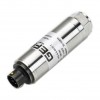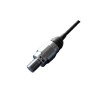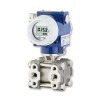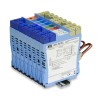It is an electrical signal which is proportional to the applied excitation voltage and is also referred to as a ratio-metric or strain gauge output.
This type of output signal is produced by a wheatstone bridge strain gauge transducer which converts imbalance in bridge resistance generated by an applied force / load to a voltage drop between two opposite corners of the wheatstone bridge circuit.
For a given fixed force, load or pressure, the voltage drop across two opposite corners of the circuit is linearly proportional to the voltage supplied between the adjacent two corners of the circuit. In a circuit diagram the wheatstone bridge is usually shown as four resistors representing the strain gauges, joined together in a diamond shape.
The output from a strain gauge sensor is directly influenced by changes in the supply voltage and the relationship between the two is expressed as a ratio of the full scale output voltage divided by the input supply voltage:
Since the output from a transducer is also linearly proportional to the force, load or the pressure being measured, the measurement units can also be incorporated into the output sensitivity specification:
Featured millivolt signal strain gauge based measurement products
 TPS Strain Gauge Pressure Sensor - Strain gauge pressure sensor with a millivolt output direct from a four arm wheatstone bridge strain gauge circuit in pressure ranges from 10 up to 1000 bar gauge.
TPS Strain Gauge Pressure Sensor - Strain gauge pressure sensor with a millivolt output direct from a four arm wheatstone bridge strain gauge circuit in pressure ranges from 10 up to 1000 bar gauge. ASM 13mm Diameter Miniature Pressure Transducer - Miniature size 1/2 inch diameter stainless steel pressure sensor with an amplified 0.5 to 4.5 Vdc output. Pressure ranges start from 10 up to 400 bar.
ASM 13mm Diameter Miniature Pressure Transducer - Miniature size 1/2 inch diameter stainless steel pressure sensor with an amplified 0.5 to 4.5 Vdc output. Pressure ranges start from 10 up to 400 bar.
Glossary of Measurement Signal technical terms
- 2 Wire
- 3 Wire
- 4 to 20 mA Current Loop Output Signal
- 4 Wire
- Amplified Voltage Output
- BFSG – Bonded Foil Strain Gauge
- Deadband
- FSO – Full Scale Output
- HART®
- NC – Normally Closed
- NO – Normally Open
- Piezoresistive Strain Gauges
- Ratiometric
- Span
- Span Offset
- Span Sensitivity
- Square Root Extraction
- Threshold
- Totalizer
- Transducer
- Transmitter
- TSL – Terminal Straight Line
- TSS – Thermal Span or Sensitivity Shift
- Turndown Ratio
- USB
- Vented Cable
- Wheatstone Bridge Strain Gauge
- Zero Offset
- Zero Tare
Help from Measurement Signal resources
- Why use 4-20mA and 3-15 psi rather than 0-20mA & 0-15psi
- Supply voltage and load resistance considerations for pressure transmitters
- What is the difference between zero offset and zero drift?




